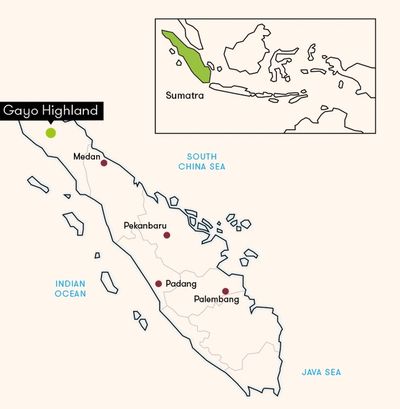Signed in as:
filler@godaddy.com
Signed in as:
filler@godaddy.com

This classic wethulled lot comes from Ara Cahayani Gayo co-op in Aceh, northern Sumatra. The co-operative was started by 25 farmers but now works with 2,753 smallholder farmers in the Bener Meriah subregion, also known as the Gayo Highland.
The co-operative supports its members with a range of social and sustainability initiatives such as after-school childcare, a pension scheme, business consultation, agronomic training, seedling distribution, and infrastructure investment.

The wet-hulled process - known in Indonesia as “Giling Basah” - is largely unique to the islands and produces a characteristic cup profile which is fruity & complex with some pleasant earthy notes.
Coffee beans from this area have a distinctive bluish colour, which is attributed to the processing method and lack of iron in the soil.
Ripe cherries are handpicked, pulped the same day and fermented overnight. The wet parchment (locally known as Gabu) in then sundried for 1-2 days after which the moisture content is still high (around 40%). The coffee is then hulled (the parchment or husk of the bean is mechanically removed) and then dried in the sun until the optimum moisture content is reached (around 12.5-13%).
The dried coffee is then double handpicked to remove any defects before being bagged in Grainpro for export.
Seedlings from the Yemen were first sent to the Dutch governor of Batavia (now Jakata) in 1696 by the Dutch governor based in Malabar - India. The first seedlings failed due to flooding in Batavia. A second shipment of seedlings was sent in 1699 with Hendrik Zwaardecroon.
Successful growth of this second batch of seedlings, saw the first exports of coffee from Java to Europe in 1711 by the Dutch East India Company, formally Verenigde Oostindische Compagnie .
Java was the coffee king of Indonesia (aka the Dutch East Indies) for at least 100 years after cuttings first arrived from Ceylon before coffee of any significant volume was grown on other islands. And well into the 20th century, much coffee grown throughout Indonesia was called Java.
Today, more than 90% of Indonesia's coffee is grown by smallholders whos farms average aproximately one hectare. With the progression toward organic production, many farmers’ cooperatives and exporters are internationally certified to market organic coffee.

The online store will be closed from 15th of December until the new year. Thank you to all our customers for supporting our small business, it means the world to us.
Have a very Merry Christmas.